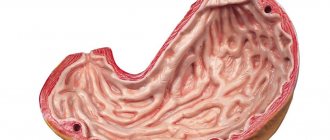General characteristics of the disease
There are two types of gastric erosions:
- acute (flat, hemorrhagic);
- chronic (“full”, hyperplastic).
Erosion of the antrum of the stomach is characterized by:
thinning of the epithelial layer of the mucosa lining the inner surface of the stomach;
superficial manifestations, with changes in structure;
the presence of superficial lesions on the mucosa, which subsequently, in the absence of proper treatment, tend to deepen.
Timely treatment of erosion of the antrum of the stomach is very important, since otherwise this pathology can lead to complications such as:
development of gastric erosions into ulcers.
The antrum carries out a number of essential functions of the stomach, including:
• dilution of the food bolus;
• carrying crushed food into the duodenum;
• production of mucus necessary to neutralize hydrochloric acid contained in gastric juice.
The antrum occupies about one third of the entire area of the stomach and at the same time is the connecting link between the stomach and intestines. Any damage or disease to the antrum can lead to serious consequences for the gastrointestinal tract.
Types of disease
Erosion of the stomach, in particular the antrum, is divided into types according to two basic principles:
by stages of development;
according to morphological symptoms.
These approaches make it possible to give a comprehensive description of the entire variety of erosions that occur in the antrum.
Classification by stage of disease development
According to this approach, two main forms of the disease are distinguished:
In the acute form of the disease, insufficiency of the epithelial layer of the gastric mucosa is observed. The damage is minor; with adequate treatment, it heals within two weeks, leaving no traces in the form of scars.
With the development of the chronic form of the disease, changes in the mucous membrane reveal the following features:
a constant inflammatory process that threatens to spread over time to other parts of the stomach;
degenerative changes in the gastric glands, which significantly affects the quality of food digestion, as the quantity and quality of gastric juice produced decreases.
Important! Without proper treatment, a chronic form of erosion of the antrum of the stomach can lead to irreversible changes in the mucosa, which will significantly affect the patient’s future health and quality of life.
Classification according to morphological symptoms
According to this classification, antrum erosions are divided into the following types.
Complete erosions, which are a fairly common type of disease. This type of disorder in question may be called hyperplastic erosion. Processes of a hyperplastic nature tend to grow tissue through increased cell division. With this type of disease, moderate swelling of the affected tissue is observed. As a rule, such erosions are located on the folds of the folds of the stomach.
Symptoms of gastric antrum cancer
Among the clinical symptoms accompanying malignant neoplasms of the stomach, several groups can be distinguished:
- general (asthenic syndrome, anemia);
- gastric (dyspeptic complaints, pain syndrome);
- associated with distant metastases (at stage 4) and characterized by damage to specific organs and structures.
According to the nature of the course, malignant tumors of the stomach have 3 clinical variants:
- latent (asymptomatic);
- painless;
- with pain syndrome.
At the initial stage, cancer can develop asymptomatically or be accompanied by a clinical underlying disease. Most patients (2/3) present with complaints typical of chronic gastritis. They experience periodic discomfort, a feeling of fullness in the stomach after eating, belching, heartburn, nausea, vomiting, bloating and other symptoms.
Sometimes the first sign of cancer is a palpable tumor in the stomach, which is typical for a latent form of the disease. As a rule, severe pain syndrome soon follows.
In order not to miss the development of malignant formation in the antrum, you should use the recommendations of A.I. Savitsky, who back in 1951 created a symptom complex of “small signs”. He stressed the importance that the initial manifestations of cancer must be assessed in totality.
This syndrome includes:
- Unexplained regular or constant weakness, rapid physical and mental fatigue, decreased performance.
- Unmotivated persistent loss of appetite, up to anorexia, with a predominant aversion to meat foods.
- Sudden loss of body weight.
- A systematic feeling of gastric discomfort, when periodically or constantly after eating there is a feeling of heaviness, fullness of the stomach, pain, as a result of which a person becomes picky in choosing food.
- Changes in the emotional background - the patient becomes withdrawn, alienated, loses interest in the environment, up to apathy and deep depression.
When a tumor of the antrum becomes infected, signs of intoxication of the body appear. If the gastric neoplasm is complicated by bleeding , typical symptoms will be observed - vomiting “coffee grounds”, tarry stools, tachycardia, severe weakness, dizziness, even fainting. When wall is perforated, sharp unbearable “dagger pains”, cold sweat, a sharp deterioration in general condition, and sometimes loss of consciousness will appear. Also, a tumor located in the antrum can completely block the exit from the stomach into the duodenum, which will lead to stagnation of food and the corresponding clinical picture - vomiting of eaten food, pronounced “heaviness” in the epigastrium, exhaustion, etc.
If cancer metastases have affected the liver, characteristic manifestations will be jaundice, itching, pain and discomfort in the right hypochondrium. With carcinomatosis, the main symptom will be ascites (accumulation of fluid in the abdominal cavity). Constipation and abdominal pain may indicate Schnitzler metastasis (tumor of the pouch of Douglas).
Symptoms of the disease
The symptoms of such diseases are very clearly defined and manifest themselves in the form of the following signs:
hungry, night pain localized in the middle abdomen;
periodic vomiting if there is constant spasm of the atrum muscles. There may be blood in the vomit;
change in habitual dietary tastes;
in some cases – taste perversion, weight loss;
decrease in hemoglobin level if erosions bleed;
problems of the skin, hair, nails that arise due to the inevitable lack of nutrition and the development of anemia with this disease.
Erosions are diagnosed only endoscopically. Clinically, the symptoms resemble those of gastritis - inflammation of the gastric mucosa. Therefore, FGDS is needed to confirm the diagnosis.
Treatment, methods
To ensure the adequacy of the therapeutic measures taken, a thorough diagnosis is carried out aimed at identifying the causes of this disease. Chronic forms require more attention during diagnosis, since the chronic course of the disease in some cases threatens to develop into a malignant pathology.
For this pathology, the following medications are most often prescribed:
antibiotics are indicated only if the bacterial nature of the erosion is established (a breath test or other methods for determining Helcobacter pylori are performed). CB eradication schemes – 2- and 3-step or treated with combination drugs: Pilobact and Clatinol, according to the instructions;
gastroprotectors, their action is aimed at protecting the mucous membrane (bismuth preparations - De-Nol);
anticides that reduce acidity levels (Phosphalugel; Gasterin gel);
enveloping preparations (flax seed decoction);
prokinetics that normalize peristalsis;
proton pump inhibitors, which reduce the level of production of pepsin and hydrochloric acid in gastric juice.
Therapy for this pathology is based not only on taking medications, but also on a complete change in the patient’s diet. Erosions will not be able to heal unless the following nutritional principles are followed:
fractional meals, that is, eating them every two hours in very small portions;
avoiding hot and cold foods;
exclusion of fried foods in favor of steamed ones;
limiting the amount of salt consumed;
complete rejection of spices, spices, sugar.
If you have this disease, it is recommended to avoid consuming a number of foods and drinks, including:
canned food, preserves, pickles;
all types of smoked meats;
all types of fried foods;
soups with rich, fatty broths;
root vegetables that have a pungent taste, namely turnips, radishes, radishes and others;
coffee and black tea.
To heal erosions, it is necessary to consume foods that promote the formation of natural digestive enzymes in the stomach. These products include:
low-fat dairy products;
porridge cooked in water, for example, oatmeal or semolina;
eggs, no more than three per week.
The proposed diet is mandatory for the patient for at least two months, and then, depending on the results of treatment, the patient is allowed to make small deviations from this diet in order to gradually return to the patient’s usual food.
The acute form of this disease in most cases is cured within two weeks. When the disease becomes chronic, treatment takes longer.
In some cases, when conservative treatment does not help, they resort to a surgical approach, which is based on removing part of the stomach as part of abdominal surgery. As a rule, the main indication for such an operation is severe bleeding, which threatens the patient’s life. Now there are methods of minimally invasive surgery. A more gentle method of surgical intervention is cauterization of erosions using an endoscope.
Within the framework of modern medicine, treatment of the stomach is successfully carried out at almost all stages of development. However, timely treatment can avoid many serious consequences. Remember, only a timely visit to the doctor makes it possible to start treatment on time and prevent complications!
Biopsy is the removal of material with forceps for histological examination (under a microscope) in order to clarify the diagnosis (gastritis, erosion, ulcer, polyp, cancer and much more). Usually 2-3 to 5 pieces are taken. The test collection process is painless. You just need to just lie down for a few minutes. Bleeding may be a complication when taking a biopsy. If the risk of bleeding is high, the endoscopist should refuse to perform a biopsy, especially on an outpatient basis, and recommend performing an FGDS with a biopsy in a hospital setting or prescribing a control FGDS after a certain time.
GASTRITIS. Chronic gastritis is an inflammation of the gastric mucosa; it can be atrophic, hyperplastic or atrophic-hyperplastic.
Helicobacter. A microbe that causes some stomach diseases.
GER (Gastro-esophageal, i.e. Gastroesophageal reflux) . Rejection of stomach contents into the esophagus.
Gastroesophageal prolapse. Throwing of the gastric mucosa into the esophagus. It is not a hiatal hernia.
DGR (Duodeno-gastric reflux). The reflux of bile from the duodenum into the stomach.
CARDIA is a sphincter (sphincter) between the esophagus and stomach
PAPULA . Previously, it was called chronic erosion. There are UMBILICAL (Mature, Active) papules and SIMPLE (Immature, Inactive) papules.
PAPULOSIC GASTROPATHY. Single papules in different parts of the stomach (antrum, body) or multiple papules in one part of the stomach.
PYLORUS is a sphincter (sphincter) between the stomach and the bulb, 12 p.c.
POLYP. Pathological proliferation of tissues protruding above the mucous membrane from several mm to 1-2 cm or more. They are “pedunculated” or on a broad base, like a wart. Depending on the type, they can produce fast or slow growth. When taking a biopsy, they sometimes cause bleeding of varying degrees of intensity. Removed endoscopically in a hospital setting.
SYMPTOM OF “SEMONA.” An indirect sign of pathology G.V.P. (biliary tract). Endoscopically they look like inclusions of semolina.
CANCER. Malignant neoplasm. Endoscopically, it is possible to detect cancer at an early stage, when there are no metastases yet and the effect of treatment is most favorable.
ROW . Cicatricial ulcerative deformity as a consequence of an ulcer
H.H.D.S. (Sliding hiatal hernia, or Hiatal hernia) - the location of the cardiac part of the esophagus and, or part of the stomach, in the chest, i.e. above the diaphragm.
Nodular mucosa is characteristic of hyperplastic gastritis.
Forecast
As in cases with other types of malignant neoplasms, the prognosis of the disease directly depends on the stage of detection of the disease and on the speed of providing assistance to the patient. The earlier a tumor is detected, the easier it is to cure it. However, antrum cancer is more dangerous than other types, as it has a rapid and aggressive course. In addition, even complete removal of the tumor, adjacent healthy tissue and lymph nodes does not guarantee the absence of relapses in the future.
Most often, a tumor of any part of the stomach is detected in the final stages, when it is too late to perform surgery or it is simply useless due to metastases to distant organs. The survival rate in such cases is about 20%.
Approximate survival statistics depending on the detected stage look like this:
- Stage 1: 80 – 90%. However, at the initial stage, a tumor can only be detected by chance;
- Stage 2: up to 60%. Even at this stage, cancer is detected in only 6% of patients;
- Stage 3: up to 25%;
- Stage 4: up to 5%.
What are papules in the stomach and their symptoms
The opinions of gastroenterologists regarding the fact that erosion is the primary stage of gastric ulcer are divided. Some are inclined to believe that this is true, while others argue that erosion is an independent painful form. Papules on the mucous membrane of the organ resemble round or irregular shaped ulcers and have a yellow or red tint. Such a lesion can be localized in any part of the gastrointestinal tract and affects exclusively the superficial layer of the organ, without penetrating into the tissue of the muscle plate.
Papules can be single or multiple. Symptoms of the appearance of erosive defects are:
- severe pain, which is characterized by its constancy;
- weakness, lack of appetite;
- belching, heartburn, attacks of nausea;
- in the chronic stage, gastric bleeding may occur;
- anemia;
- bloody stools.
With lesions of this type, pain is often observed at night.
Treatment of papules in the stomach is not an easy task, since in most cases they appear against the background of other diseases and therapy, which has a local effect, only temporarily heals the lesions.
Symptoms
A localized neoplasm in the antral zone of the stomach, due to its aggressiveness and intensive growth rate, gives a bright, rapidly developing clinical picture. As the tumor grows and fills the lower part of the stomach, it affects the pyloric area, which leads to difficulty in evacuating the food bolus further into the duodenum. Against the background of chronic food retention, the corresponding symptoms develop:
- belching with a sharp, unpleasant aroma;
- heartburn and a feeling of tightness in the chest;
- feeling of fullness and distension in the stomach;
- bloating;
- nausea, which often turns into vomiting.

As the symptoms intensify, patients begin to independently induce a gag reflex, since relief occurs when food masses exit through the esophagus. As a result, the body does not receive the necessary set of microelements and vitamins from the food consumed. On the contrary, food blockage in the stomach causes rotting, fermentation of undigested foods, and severe intoxication develops. This causes other, more severe symptoms:
- exhaustion due to refusal to eat and vitamin deficiency;
- loss of ability to work;
- irritability due to helplessness;
- refusal to eat;
- sudden weight loss, turning into severe anorexia.
Infiltrated stomach cancer in the antrum, as it grows, is expressed under the influence of acidic digestive juice in the stomach. The tumor tissue begins to disintegrate, causing frequent bleeding from the vessels into the gastric lumen. Since the organ simultaneously contains decomposing food, toxic substances are formed as a result of interaction with the blood. The gradual accumulation of toxins causes:
- fever, fever;
- vomiting with dark or scarlet blood;
- the appearance of tarry (blackened) stools.
An overgrown tumor, fed by living tissues of the stomach, provokes wrinkling and reduction of the organ in size. The cancer patient feels constant pressure, bloating, and heaviness after a minor snack. The patient gets full from small amounts of food. In the last stages of cancer, signs of metastasis to other organs are added to the existing symptoms. Depending on which organ is affected, the corresponding picture will appear. But more often the duodenum is the first to be affected, against which rotten belching and obstructive jaundice appear.
Causes and diagnosis
Erosion of the mucous membrane can be characterized as “corrosion” of the upper layer of the organ. This pathology can be caused by many factors:
- presence of chronic liver diseases;
- vascular pathologies;
- diabetes;
- burns of the mucous membrane by chemical vapors or liquids;
- intoxication of the body;
- surgical intervention in the organ;
- frequent eating of too spicy and/or hot foods;
- poor quality of chewing food;
- bad habits (smoking, drinking alcohol);
- entry of bile into the organ cavity;
- increased acidity of gastric juice with parallel resistance of the mucous membrane;
- long-term use of NSAIDs, antibiotics, heart medications;
- prolonged exposure to stress.
Doctors say that stomach papules do not degenerate into malignant formations, but can appear in parallel with these tumors, and also occur with inflammation in the intestines, liver failure, pneumonia and some cardiovascular diseases.
Diagnosis of gastric erosion is carried out using endoscopic examination. Gastrofagoduodenoscopy, taking a piece of tissue from the pathogenic area for further examination, as well as stool analysis for the presence of blood impurities - this option gives a complete picture of the patient’s condition and makes it possible to establish an accurate diagnosis.
Experts note that the presence of papules and ulcers on the walls of the organ and duodenum are the cause of bleeding in the gastrointestinal tract and occupy second place after gastric ulcers.
Diagnosis of gastric antrum cancer
Diagnostic measures for stomach tumors always begin with a survey, history taking and examination of the patient. The doctor finds out whether the patient had relatives who died of cancer, whether the person has bad habits, chronic diseases of the digestive system, etc. Further diagnosis has two objectives: to establish the presence and spread of the tumor process in the antrum of the stomach and to detect distant metastases.
The survey plan includes:
- laboratory tests;
- endoscopic examination of the esophagus, stomach, duodenum, with targeted sampling of material from 6-8 different points;
- analysis of gastric juice;
- X-ray methods.
Additionally, the following may be prescribed: ultrasound of the stomach, CT scan of the abdominal cavity and chest, skeletal scintigraphy, blood for tumor markers (CEA, CA19.9, CA72.4 and SCC) and other studies.
Types of erosive lesions of the stomach
The duration of symptoms in a patient depends on what type of papules affected the wall of his stomach. Papules are distinguished:
- According to their number on the surface of the organ:
- single formations (1-3 papules are located in different parts of the stomach);
- multiple erosions (several formations localized in one place).
- According to the degree of disease:
- the acute form is characterized by the appearance of defects, in most cases, at the bottom of the organ or its walls. Pathological sites are marked by slight infiltration of lymphocytes and the presence of non-globular protein, which is formed from fibrinogen;
- the chronic form is manifested by erosive formations of the antrum of the stomach, consisting of granular tissue, which look like bright red inflammatory foci with swollen small blood vessels.
- According to pathological features:
- hemorrhagic (the presence of a blood layer on the surface of erosions is noted);
- superficial, flat or incomplete (characterized by the presence of pure defects or a white layer. Erosion is framed by an inflammatory rim);
- hyperplastic or complete (papules are located on the surface of the folds, are similar in appearance to polyps, and often become chronic).
- By appearance:
- aphthous papules (covered with a yellow coating, which makes erosions similar to aphthae - whitish, grayish or yellowish ulcers in the mouth);
- umbilical or also called umbilical (they have a characteristic shape with a retracted center).
How to treat
Papules in the stomach are also called gastroduodenal erosions. Gastroenterologists note that this disease is detected in 20% of patients undergoing endoscopic examination. Such damage to the mucous membrane of an organ is dangerous because a person may experience asymptomatic internal bleeding, which entails the development of anemia.
Hemorrhagic papules can cause severe bleeding. They are manifested by vomiting and loose stools with copious amounts of blood. In this case, the person needs emergency hospitalization and emergency assistance from specialists.
In order to exclude such manifestations, it is necessary to carry out timely diagnosis of erosive lesions. Therapy for pathology is complex and is aimed not only at removing symptoms and abnormal processes on the wall of the organ, but also at eliminating the source of the disease.
Treatment of papules in the stomach is controlled by regular diagnostics - abdominal endoscopy. If the disease is caused by Helicobacter bacteria, then antibiotics are used. In other cases, treat by blocking H2 receptors, also called histamine receptors. Cytoprotectors are used for rapid healing of erosions on the gastric mucosa. The patient may also be prescribed laser treatment for pathological areas, but this procedure is performed exclusively in a hospital.
Therapy for gastroduodenal erosions is carried out in conjunction with a strict diet. Otherwise, it will be impossible to achieve the desired result.








